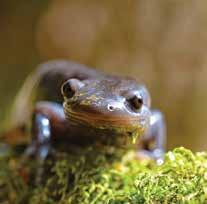
3 minute read
DIGGING FOR ANSWERS
Students explore real-world ecological issues in the new Advanced Environmental Science Research class.
by Hannah Van Sickle
Advertisement
The Jefferson salamander has a lot on its small shoulders: it regulates the food chain to ensure a vibrant ecosystem. If the population of Jefferson salamanders is faltering, the environment might be, too. Sophie Reed ’19 wondered: How were the Jefferson salamanders that lived at the base of the Mountain faring? She decided to investigate further.
Reed was one of 18 students enrolled in Berkshire’s new yearlong Advanced Environmental Science Research (AESR) course, housed in a tech-free classroom in the rededicated Chevalier Senior Lodge. Students chose a research project—in Reed’s case, the salamanders—and pursued answers to real-world ecological issues.
“It was a bit daunting at first,” Reed says of her endeavor to track the species’ population density in its rural habitat. Despite the Jefferson salamanders living in close proximity to healthy vernal pools behind East Campus, she feared the community knew little about the species. This, coupled with the fact that salamanders are unpredictable, quickly gave shape to Reed’s research. “I became interested in the ways in which our school community affects the species near us, and I learned so much this year.”

Jefferson salamander is a mole salamander that spends larger amounts of time underground than other breeds. They can be seen above ground during the mating season, which takes place in early spring.
Photo by Dom Sayler
At the helm of AESR is teacher Cait Ward ’08, who says the curriculum allows students to apply the knowledge they gained in AP Environmental Science to potentially advance science or implement sustainability measures as they uncover answers to their questions. For example, Reed is in the process of lobbying the state of Massachusetts to legally protect the vernal pools on campus, where the salamanders breed year after year.

AESR teacher Cait Ward ’08 works with Jeff McKee ’19 and Kat Erazo ’19 in the Chevalier Senior Lodge.
Photo by Gregory Cherin Photography
Ward also credited the Chevalier Senior Lodge, which is nestled in a grove of pine trees on campus, for evoking a sustainability mindset. “Teaching and learning out of Chevalier this fall has been a dream,” Ward wrote in a letter commemorating the building’s rededication. “Walking through the pines [to class] has quickly become the highlight of my day, as the journey through the forest immediately sets the stage for conversations around environmental stewardship, ecological sustainability, and technology.”
Science Department Chair Dr. April Burch shares Ward’s enthusiasm for AESR, calling it “a class that will support advanced research opportunities for students who are passionate about ecology, environmental stewardship, and social justice issues related to environmental science.”
Burch continues: “It has been so exciting to see Cait bring her vision for high-level environmental research to life with this new offering. She has created a truly unique educational experience for students, one that I’m sure they will hold fondly.”
Ward is specifically encouraging her students to focus their research on topics related to the Mountain, which aligns with the School’s strategic priority to “incorporate the Mountain more fluidly into our classes.” AESR, Ward says, has provided tangible access to the Mountain in both a physical and a spiritual sense, and many students have begun to “build familiarity with the physical space and recognize the importance of these surroundings to their research.”
Carter Allen ’19’s interest in climate change inspired him to enroll in the class and learn more about protecting the local ecosystem. In his pursuit, he asked: What factors make the ecosystems surrounding Berkshire School unique? Allen made clear his dual intent: “To bring more awareness to the Mountain and hopefully inspire people to spend more time on it.”
Allen enjoyed both the challenge and the independence of the class. “Not only do we get to completely choose what we are going to study, but we choose our progression and our guidelines; it’s been very rewarding,” he says.
And then there is the teacher: “If you are eager and wanting to learn, Ms. Ward will do everything to help you succeed,” says Annabel Pirkle ’19, who studied the effects of climate change on sugar maple trees. Her classmates describe Ward as equally passionate about the environment and their own success.
Most importantly, Ward wants her students to develop a personal accountability to the environment. “We talk a lot about what it means to be a responsible human, one who is rooted in obligation to caring for their surroundings,” she says. This then provides a foundation for what Ward calls “diving in to environmental issues and policy in a different way—one that connects to students’ other classes” and creates a firm connection to the very environment in which they both live and learn.
To read students’ AESR Independent Projects, go to http://bit.ly/AESRprojects.



